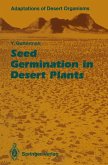For centuries biologists have been extremely interested in the structure of desert plants as examples of natural selection to harsh environmental conditions. Indeed, desert plants are frequently used as examples in many biology classes and textbooks to illustrate natural selection, but this has led to an unfortunate litany of errors and misconceptions about desert plant adaptations.
This new synthesis focuses on plants of lowland tropical and subtropical arid deserts. Readers will be surprised to discover that many features commonly ascribed to desert plants are rareley observed in the most common species. Instead, the typical structural adaptations of nonsucculent warm desert plants are now viewed as ways to maximize photosynthetic rate.
This new synthesis focuses on plants of lowland tropical and subtropical arid deserts. Readers will be surprised to discover that many features commonly ascribed to desert plants are rareley observed in the most common species. Instead, the typical structural adaptations of nonsucculent warm desert plants are now viewed as ways to maximize photosynthetic rate.








